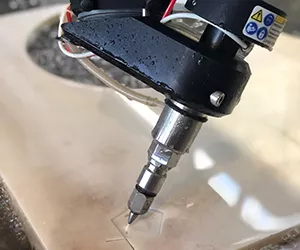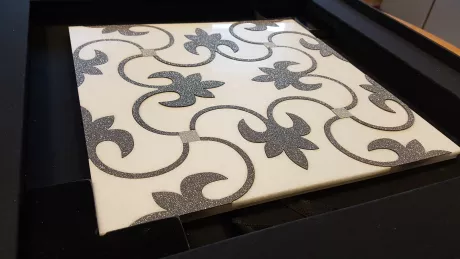Tips & Tricks
Tips for Cutting Stone and Ceramic on Your Waterjet
Pierce stone countertops without chipping. Work ceramic with minimum dust. From granite to Dekton, OMAX abrasive waterjets allow for quick, accurate, and safe machining. Fabricating with water and abrasives instead of wasting money on costly specialty saw blades ensures a cutting medium that is never dull and a fully secure process – especially with our tips for cutting stone and ceramic materials.

Tips for better stone cutting:
- Use low-pressure piercing – Stone and marble will cut easily, but piercing should typically be performed at low pressure to avoid cracking.
- Use a long lead-in – Abrading and cracking tends to happen near the pierce point, so providing a long lead-in keeps these areas away from the part.
- Veins can be a problem – Watch out for the veins in marble, as some of these can be very soft and cause your final part to fall apart, even though it may otherwise cut fine.
- Evenly support the material – Make sure that the material is evenly supported on the slats. If it is uneven, it may wobble or one section may be higher than another, which interferes with the motion of the nozzle. Material that is unevenly supported is also more likely to crack. The waterjet brick provides even support for machining.
- Use low pressure and high speed for etching – If you intend to etch stone, then use very low pressure, such as 15 ksi (100,000 kPa), and speeds as high as 150 ipm (380 cm/min). Note that the quality of etch will vary considerably depending on the stone itself.

Tips for cutting ceramic:
Ceramics vary widely in terms of their suitability for waterjet cutting. Some will cut and pierce very easily and quickly. Some will not pierce easily and may crack. Others may cut extremely slowly.
The machineability of these materials will vary between 0.01 and 1000; experimentation may be necessary to determine the machineability of materials not listed.
- Use abrasives hard enough for your material – For extremely hard ceramics, you may wish to use a very hard abrasive such as corundum (aluminum oxide). This will help cut the ceramic much faster than garnet. However, hard abrasives will also wear your mixing tube at an accelerated rate, limiting the lifespan of the tube to about an hour of use.
- Go green – Consider cutting hard ceramics while still in the "green" state.
- Reduce the pressure – Some hard/brittle ceramics may cut more easily, with less chipping and cracking, if cut at lower pressures. For example, testing in 3/8" (9.5 mm) ceramic ZTA (zirconia toughened alumina) showed good results at 20 ksi (1380 bar) pressure while cutting at higher pressures shattered the exit side of the kerf.
- Avoid microchipping
- Microchipping can occur along the edges of glass or other brittle materials. You can reduce microchipping by using the tips listed below.
- Notice the microchipping along the edges in this closeup of a glass part
- Use a finer abrasive – Use 120-150 mesh, or finer if possible. Make sure you change the abrasive size on the Pump and Nozzle Settings menu in MAKE. When you switch abrasive sizes, you'll also need to remeasure the abrasive flow rate and use the new value.
- Reduce the cutting speed and pressure – By using a lower machinability value, MAKE will slow down the cutting head, and lower pressures will further reduce microchipping.




